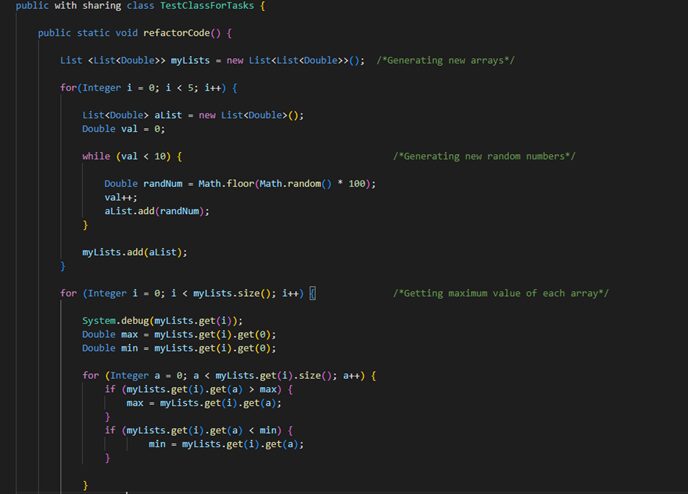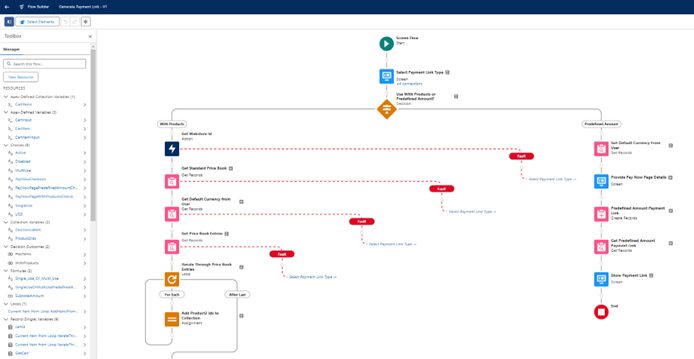Apex or Flow: When to Code and When to Click
A foundation of Salesforce’s success is providing a robust platform that caters to a wide range of business needs. A key to this is giving business users tools to write their own business applications. Two of the primary tools used for customization within Salesforce are Apex and Flow. Apex, a strongly typed programming language, allows for intricate and highly tailored customizations through code. Flow, on the other hand, leverages click-based configurations, enabling users to automate processes without writing a single line of Salesforce Apex code.
Selecting the right tool—Apex or Flow—is crucial for effective Salesforce development. The choice between coding with Apex and configuring with Flow can significantly impact the efficiency, maintainability, and scalability of your Salesforce solutions. Understanding when to use each tool can streamline your development process, ensure optimal performance, and align with your team’s skill set.
In this article, I will take you through the key features and common use cases of both Apex and Flow. We will explore the decision-making process for choosing between these two tools, providing a comparison table for quick reference. Additionally, we will offer best practices for deciding when to switch from Flow to Apex as project requirements evolve. By the end, you will have a comprehensive understanding of how to navigate the complexities of Salesforce customization, ensuring you select the right tool for your specific needs.
Table of contents

Understanding Apex: The Power of Code
Key Features of Salesforce Apex
Apex is Salesforce’s proprietary programming language, designed specifically for developing complex business logic and transaction control on the Salesforce platform. It offers a range of powerful features that enable Salesforce Apex developers to build robust and scalable applications. Here are some of the key features of Apex:
- Strongly Typed and Object-Oriented: Apex is strongly typed, meaning that every variable and expression is bound to a specific data type, ensuring type safety and reducing runtime errors. As an object-oriented language, it supports concepts such as classes, inheritance, polymorphism, and interfaces, facilitating the development of modular and reusable code.
- Database Integration: Apex provides built-in support for Salesforce Object Query Language (SOQL) and Salesforce Object Search Language (SOSL), enabling efficient retrieval and manipulation of data stored in Salesforce objects. This tight integration with the database allows for seamless data operations within the Apex code.
- Triggers and Classes: Developers can use Apex to write triggers that execute specific actions before or after changes to Salesforce records. Triggers are essential for enforcing business rules and automating processes. Additionally, Apex supports the creation of reusable classes and methods, allowing developers to encapsulate complex business logic and reuse it across different parts of the application.
- Asynchronous Processing: Apex supports asynchronous processing through future methods, batch Apex, and queueable Apex. These features enable developers to perform long-running operations and complex computations without blocking the user interface, ensuring a responsive and efficient user experience.
- Exception Handling: Apex includes robust error and exception handling mechanisms. Developers can use try-catch blocks to handle exceptions gracefully, ensuring that errors are caught and managed effectively, improving the overall reliability and stability of the application.
Common Use Cases for Apex
Salesforce Apex best practices are ideal for scenarios where advanced functionality or complex business logic is required. Here are some common use cases for Apex:
- Custom Business Processes: Apex is used to implement complex workflows, approval processes, and automation that go beyond the capabilities of declarative tools. For instance, a company might use Apex to create a multi-step approval process that involves several conditions and actions that cannot be easily configured with standard tools.
- Integration with External Systems: Apex is essential for building integrations with external applications and services. This includes making REST and SOAP API calls, processing inbound messages, and ensuring data synchronization between Salesforce and other systems. For example, an organization might use Apex to integrate Salesforce with its ERP system to ensure real-time data consistency.
- Batch Processing: Handling large volumes of data and performing operations that need to be processed asynchronously is a common use case for Apex. Batch Apex allows developers to process records in chunks, making it suitable for tasks like data cleanup, data migration, and scheduled updates.
- Custom User Interfaces: Apex is often used in conjunction with Visualforce and Lightning Web Components to develop custom user interfaces that require specific logic and interaction beyond what standard Salesforce UI components offer. This enables the creation of highly tailored user experiences.
- Enhanced Validation: While standard validation rules cover many use cases, some business scenarios require more complex validation logic that can only be achieved with Apex. For example, ensuring that certain conditions are met across multiple related records might necessitate custom validation logic written in Apex.

Understanding Flow: The Simplicity of Clicks
Key Features of Flow
Flow, also known as Salesforce Flow, is a powerful declarative automation tool that allows users to create complex business processes using a visual interface. Unlike Apex, which requires coding expertise, Flow enables users to automate tasks and business processes through clicks, making it accessible to those without programming skills. Here are some of the key features of Flow:
- Flow Builder: A user-friendly, drag-and-drop interface that allows users to design and automate business processes visually. Flow Builder simplifies the creation of workflows by providing a canvas where users can add and connect various elements to define the flow of logic.
- Variety of Salesforce Flow Types: Salesforce Flow offers a range of flow types to address diverse automation requirements:
- Screen Flows: Designed for guided user interactions, these flows lead users through a series of screens to complete tasks. Salesforce Flow best practices like data entry, lead qualification, and service request handling, ensuring accuracy and consistency through a visual interface.
- Record-Triggered Flows: Activated by changes to Salesforce records, these flows automatically perform actions in response to record creation, updates, or deletion. They are perfect for updating related records, automating workflows, and maintaining data integrity without manual intervention.
- Scheduled Flows: These flows run at predetermined times or intervals, automating routine tasks and periodic updates. Scheduled flows are useful for sending reminder notifications, performing data cleanup, and ensuring regular data quality checks.
- Platform Event-Triggered Flows: Responding to platform events, these flows enable real-time automation based on specific events within Salesforce. They are essential for high-priority alerts, inventory updates, and other immediate actions that require quick responses to critical events.
- Autolaunched Flows: Operating without direct user interaction, autolaunched flows are triggered by specific events or processes. They are crucial for backend automation tasks such as order processing, data synchronization, and integrating Salesforce with external systems.
Each type of flow serves a unique purpose, providing flexibility and efficiency in automating various business processes within Salesforce.
- Element Types: Flow supports various elements, including assignments, decisions, loops, and actions, enabling the creation of sophisticated logic without writing code. Each element serves a specific purpose, such as setting field values, making decisions based on conditions, iterating over collections, and performing actions like sending emails or creating records.
- Integration Capabilities: Flow allows integration with external systems using pre-built connectors and actions. This makes it possible to automate data synchronization and integrate Salesforce with other platforms without the need for custom coding.
- Guided Interactions: One of the key strengths of Flow is its ability to create guided processes that lead users through a series of steps or screens to complete tasks. This is particularly useful for onboarding processes, data entry, and ensuring users follow specific procedures.
Common Use Cases for Flow
Flow is well-suited for automating straightforward processes and providing user-friendly interactions. Here are some common use cases for Flow:
- User Onboarding: Automating the onboarding process for new employees or customers by guiding them through necessary steps and data entry. For example, a Screen Flow can be used to collect user information, set up initial records, and assign tasks for new hires.
- Approval Processes: Streamlining approval workflows by automating request submissions, approvals, and notifications. For instance, a manager can receive an automated email when a subordinate submits a leave request, and the manager’s approval can trigger further automated actions.
- Data Updates: Automatically updating records based on specific criteria or user actions. For example, a flow can be designed to recalculate fields, update related records, or trigger additional processes when certain conditions are met.
- Simple Integrations: Configuring integrations, like Salesforce integration with ecommerce, or between Salesforce and other systems for data synchronization without writing code. For example, automating data synchronization between Salesforce and an e-commerce platform can often be achieved through clicks, not code. This makes processes like order updates, customer data integration, and inventory management smoother and more accessible to non-developers.
- Task Automation: Automating repetitive tasks and reminders, ensuring users are notified and actions are taken automatically based on predefined triggers. For instance, a flow can be used to send follow-up emails to customers after a certain period or to create tasks for sales representatives based on changes in opportunity stages.
When to Choose Apex and When to Choose Flow
Selecting between Apex and Flow depends on various factors, including the complexity of the task, the level of customization required, and the technical expertise available. Here’s a detailed look at when to use each tool:
When to Choose Apex
Complex Business Logic:
- Apex is ideal for scenarios requiring advanced functionality that goes beyond the capabilities of declarative tools. If your process involves intricate logic, complex calculations, or custom transaction control, Apex is the right choice.
Integration with External Systems:
- When integrating Salesforce with other systems, especially if the integration requires advanced operations like handling complex data formats or managing large data volumes, Apex provides the necessary flexibility and control.
Batch Processing and Asynchronous Tasks:
- For operations involving large data sets or long-running processes that need to be executed without blocking user interactions, Apex supports asynchronous processing through batch Apex, future methods, and queueable Apex.
Custom User Interfaces:
- Developing bespoke user interfaces that require specific logic and interactions is another strong use case for Apex. Custom Visualforce pages and Lightning Web Components can be developed using Apex to meet unique user experience requirements.
Enhanced Validation and Error Handling:
- Implementing complex validation rules and robust error handling that cannot be achieved through standard validation rules or declarative tools is best handled with Apex. Apex allows for detailed control over how errors are caught and managed.
When to Choose Flow
User Interactions and Guided Processes:
- Screen flows are perfect for creating step-by-step guided processes, such as data entry, lead qualification, and service request handling. These flows enhance user interaction and ensure data accuracy through a visual, user-friendly interface.
Routine and Periodic Automation:
- Scheduled flows are ideal for automating recurring tasks and periodic updates, such as sending reminders for overdue tasks or performing regular data quality checks. They ensure that routine operations are carried out consistently and on time.
Immediate Response to Data Changes:
- Record-triggered flows are suitable for automating actions in response to record creation, updates, or deletions. These flows can update related records, replace traditional workflow rules, and ensure data integrity without manual intervention.
Real-Time Event Responses:
- Platform event-triggered flows are effective for real-time automation in response to specific events within Salesforce. They are essential for immediate actions like sending high-priority alerts or synchronizing inventory levels across systems when sales orders are placed.
Backend Automation Without User Interaction:
- Autolaunched flows operate without direct user interaction, making them perfect for backend processes such as order processing, data synchronization, and integrating Salesforce with external systems. These flows ensure that complex backend operations run smoothly without manual input.
Comparison Table of Apex and Flow
| Feature/Requirement | Apex | Rating | Flow | Rating |
| Complex Business Logic | Ideal for intricate logic and custom transaction control | ⭐⭐⭐⭐⭐ | Suitable for simpler logic through visual interface | ⭐⭐⭐ |
| Integration | Advanced operations, large data volumes | ⭐⭐⭐⭐⭐ | Basic integrations, pre-built connectors | ⭐⭐⭐⭐ |
| User Interface | Custom Visualforce and Lightning Web Components | ⭐⭐⭐ | Guided user interactions with Screen Flows | ⭐⭐⭐⭐⭐ |
| Validation and Error Handling | Detailed control over validation and errors | ⭐⭐⭐⭐⭐ | Basic validation and error handling | ⭐⭐⭐ |
| Ease of Use | Requires coding knowledge | ⭐⭐⭐ | No coding required, user-friendly interface | ⭐⭐⭐⭐⭐ |
| Development Time | Longer learning curve, more time-consuming | ⭐⭐⭐⭐ | Faster for simple tasks, slower for complex tasks | ⭐⭐⭐⭐ |
| Our Rating: | 4.1 ⭐⭐⭐⭐ | 4.0 ⭐⭐⭐⭐ | ||
Decision Factors: How to Choose Between Apex and Flow
Selecting the appropriate tool between Apex and Flow involves careful consideration of various factors. How to assess the requirements of a project to decide between these two powerful tools:
1. Complexity of the Task
Simple vs. Complex Processes:
- For straightforward automation and business processes, Flow is often the best choice due to its user-friendly, visual interface. Examples include guided data entry, basic record updates, and simple approval workflows.
- For complex business logic, intricate calculations, or processes that require custom transaction control, Apex is more suitable. Apex’s robust programming capabilities allow for the implementation of advanced features and functionalities that Flow cannot handle.
2. Required Customization
Standard vs. Custom Solutions:
- If the task involves standard automation and can be accomplished using out-of-the-box solutions, Flow is typically sufficient. This includes tasks like scheduled notifications, basic data manipulations, and simple integrations.
- If the task demands highly customized solutions, such as custom user interfaces, integration with non-standard external systems, or unique business logic, Apex is necessary. Apex offers the flexibility to tailor solutions precisely to meet specific business needs.
3. Performance Considerations
Efficiency and Scalability:
- Flow is generally suitable for small to medium-scale operations where performance requirements are not overly stringent. However, as the complexity and volume of data increase, Flows can become slower and less efficient.
- Apex, with its optimized code execution and asynchronous processing capabilities, is better suited for high-performance requirements and large-scale operations. For tasks that involve processing large datasets or require efficient handling of complex transactions, Apex provides superior performance and scalability.
4. Maintenance and Manageability
Ease of Updates and Modifications:
- Flow’s visual interface makes it easier to understand, update, and modify automation, especially for administrators and users with limited coding experience. This can lead to faster iterations and simpler maintenance for straightforward processes.
- Apex, while more powerful, requires coding expertise for updates and modifications. The complexity of maintaining Apex code can be higher, but it offers greater control and precision for intricate processes.
5. Skill Set of the Team
Administrator vs. Developer Skills:
- Flow is designed to be accessible to Salesforce administrators and business users who may not have programming skills. Its point-and-click configuration is intuitive and can be leveraged quickly by non-developers.
- Apex requires knowledge of programming languages, primarily Apex itself, as well as an understanding of Salesforce’s architecture and development environment. Teams with skilled developers are better suited to leverage the full potential of Apex.
6. Integration Needs
Simple vs. Complex Integrations:
- For simple integrations, such as connecting Salesforce with common applications using pre-built connectors, Flow is often sufficient. Examples include synchronizing data with an e-commerce platform for order updates and customer data integration.
- For more complex integrations, especially those requiring advanced operations, custom data transformations, or real-time data processing, Apex is the preferred choice. Apex provides the necessary tools to handle complex integration scenarios effectively.
Best Practices for Deciding When to Switch from Flow to Apex
- Start with Flow for Prototyping: Use Flow to quickly prototype and validate business processes. If the requirements evolve and become more complex, consider switching to Apex for a more robust and scalable solution.
- Monitor Performance: Regularly assess the performance of your Flows. If you notice significant delays or inefficiencies, it may be time to transition to Apex to optimize performance.
- Evaluate Maintenance Efforts: Consider the long-term maintenance implications. If a Flow becomes too complex to manage or update easily, rewriting it in Apex might simplify ongoing maintenance and future enhancements.
- Balance Expertise and Needs: Align the choice of tool with your team’s expertise. Use Flow for tasks that can be managed by administrators and business users, and leverage Apex for tasks that require developer-level customization and control.
What About DevOps?
In our next article, we’ll explore the role of DevOps in Salesforce development, focusing on the CI/CD (Continuous Integration/Continuous Deployment) tradeoffs when using Apex and Flow. We’ll discuss how these tools impact your DevOps practices, including deployment speed, automation complexity, and maintainability. Discover why some DevOps professionals prefer Flow for its ease of use, while others opt for Apex to handle more intricate tasks. Stay tuned to uncover these insights and make informed decisions for your Salesforce projects.
Wrapping Up
Navigating the landscape of Salesforce customization, it’s clear that both Apex and Flow have their unique strengths and applications. Knowing when to use each can make a significant difference in your project’s success and efficiency.
Apex is your powerhouse for handling complex business logic and customizations. It’s perfect for integrating with external systems, batch processing, and building custom user interfaces. While it offers unparalleled control and functionality, it does require a solid grasp of coding and a higher level of maintenance. Apex is best suited for teams with experienced developers who can harness its full potential for sophisticated, large-scale projects.
Flow, on the other hand, is like your everyday multitool. It’s incredibly user-friendly and perfect for automating straightforward processes. Whether you’re guiding users through data entry, setting up automated reminders, or handling routine data updates, Flow gets the job done quickly and efficiently. Its visual, click-based interface makes it accessible to admins and business users without a background in coding. While Flow may struggle with very complex tasks or large data sets, its ease of use and rapid deployment capabilities make it an invaluable tool for many day-to-day needs.
Deciding between Apex and Flow boils down to understanding your specific needs and the complexity of the tasks at hand. For simpler, user-driven processes, Flow is often the way to go. It allows for quick prototyping and immediate implementation, making it ideal for getting things up and running fast. As your requirements become more complex, or if you need more robust performance and detailed control, Apex becomes the better choice.
Here are a few best practices to keep in mind:
- Start Simple: Begin with Flow for straightforward tasks and prototypes. This allows you to quickly validate your processes and make adjustments on the fly.
- Monitor Performance: Keep an eye on how your Flows are performing. If you notice any slowdowns or inefficiencies, it might be time to consider switching to Apex for those tasks.
- Think Long-Term: Consider the long-term maintenance of your automations. If a Flow is becoming too complex and unwieldy, rewriting it in Apex could simplify maintenance and future updates.
- Match Skills to Tools: Align your choice of tools with your team’s skills. Use Flow for tasks that can be handled by admins and business users, and reserve Apex for scenarios that require developer-level customization and control.
The decision between “clicks” and “code” is ultimately about balance. By leveraging the strengths of both Apex and Flow, you can create powerful, tailored Salesforce solutions that meet your organization’s needs and drive business success.






